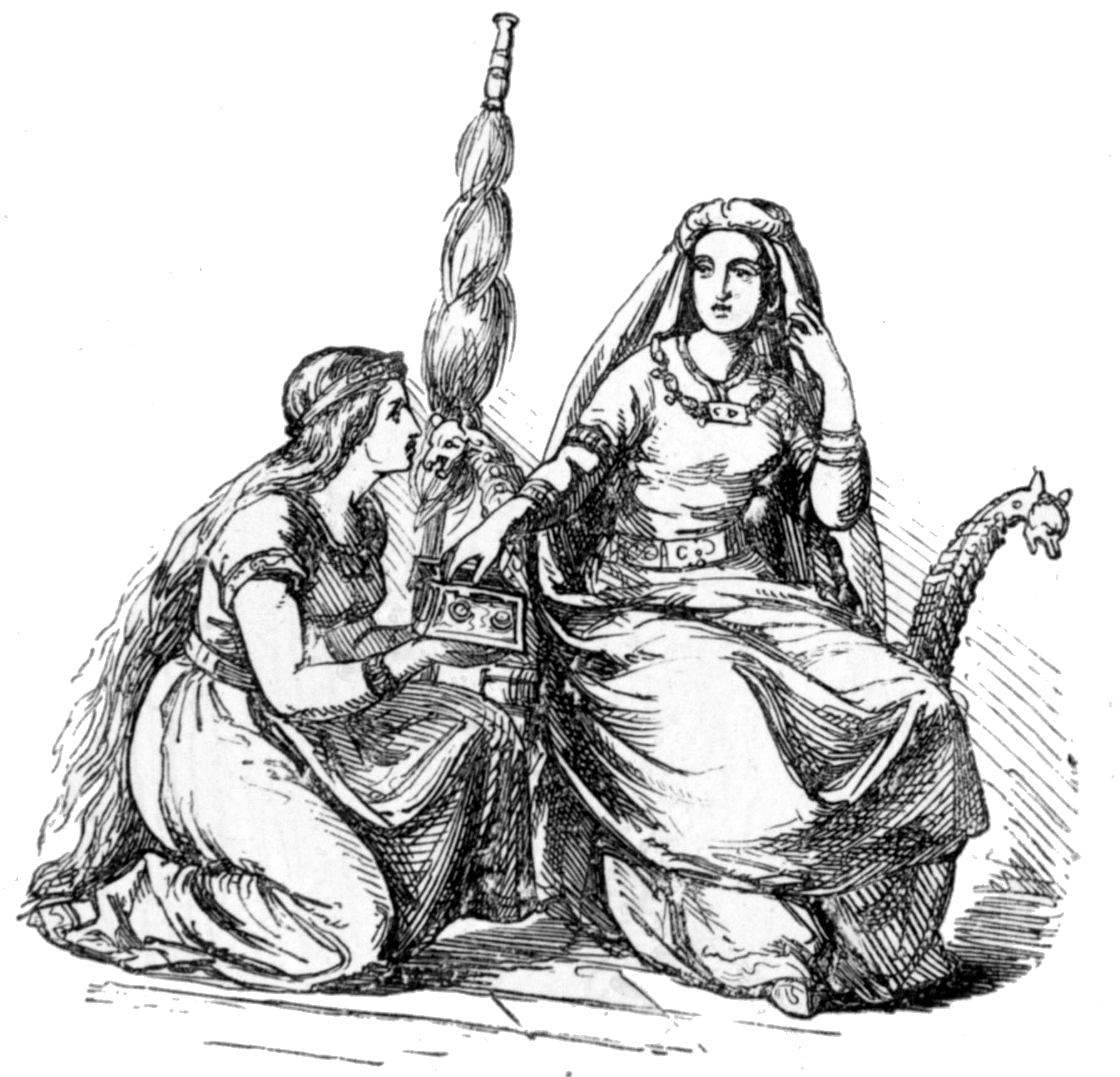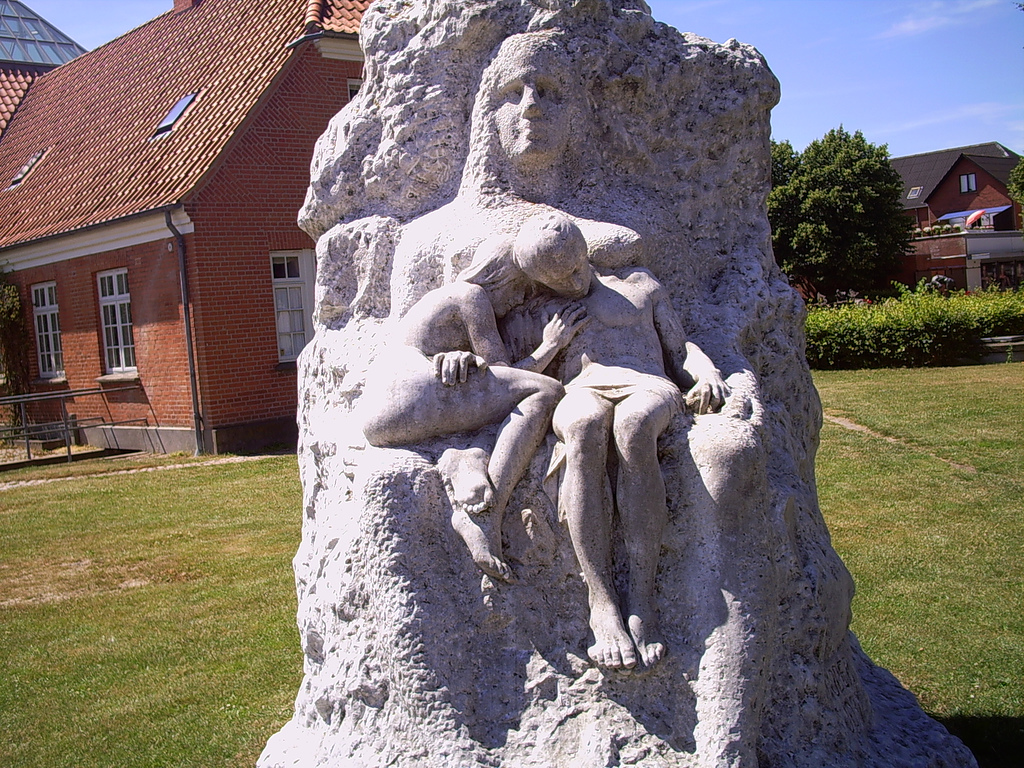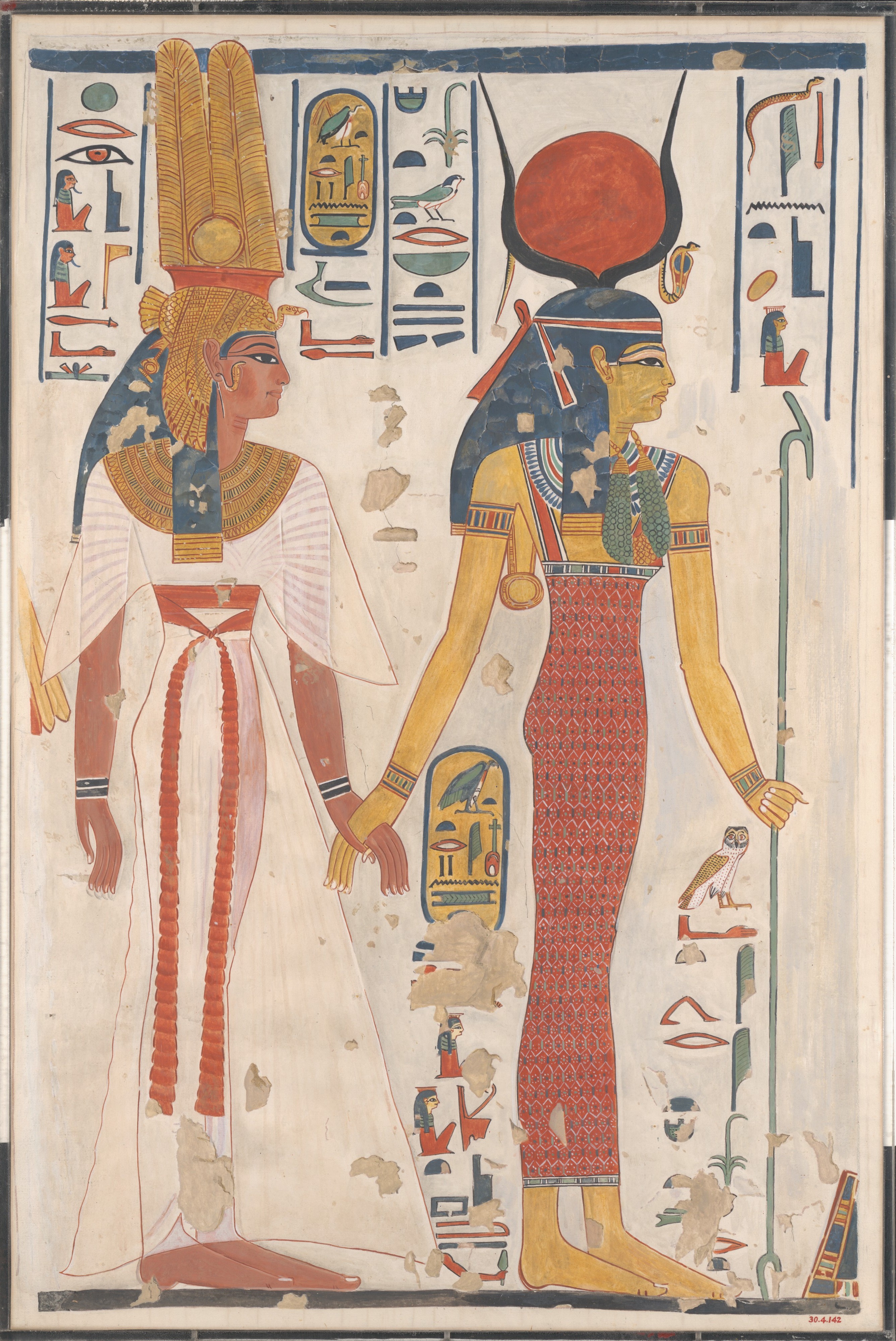|
Frigg
Frigg (; Old Norse: ) is a goddess, one of the Æsir, in Germanic mythology. In Norse mythology, the source of most surviving information about her, she is associated with marriage, prophecy, clairvoyance and motherhood, and dwells in the wetland halls of Fensalir. In wider Germanic mythology, she is known in Old High German as , in Lombardic language, Langobardic as , in Old English as , in Old Frisian as ''Frīa'', and in Old Saxon as , all ultimately stemming from the Proto-Germanic theonym *''Frijjō''. Nearly all sources portray her as the wife of the god Odin. In Old High German and Old Norse sources, she is specifically connected with Fulla, but she is also associated with the goddesses Lofn, Hlín, Gná and Hófvarpnir, Gná, and ambiguously with the Earth, otherwise personified as an apparently separate entity Jörð (Old Norse: 'Earth'). The children of Frigg and Odin include the gleaming god Baldr. The English weekday name Friday (ultimately meaning 'Frigg's Day') b ... [...More Info...] [...Related Items...] OR: [Wikipedia] [Google] [Baidu] |
Fulla
Fulla (Old Norse: , possibly 'bountiful') or Volla (Old High German, 'plenitude') is a Ásynjur, goddess in Germanic paganism, Germanic mythology. In Norse mythology, Fulla is described as wearing a golden band and as tending to the Fraxinus excelsior, ashen box and the footwear owned by the goddess Frigg, and, in addition, Frigg confides in Fulla her secrets. Fulla is attested in the ''Poetic Edda'', compiled in the 13th century from earlier traditional sources; the ''Prose Edda'', written in the 13th century by Snorri Sturluson; and in skaldic poetry. Volla (''Folla'') is attested in the "Horse Cure" Merseburg Incantations, Merseburg Incantation, recorded anonymously in the 10th century in Old High German, in which she assists in healing the wounded foal of Phol and is referred to as Frigg's sister. Scholars have proposed theories about the implications of the goddess. Name The Old Norse name ''Fulla'' has been translated as 'bountiful'. It stems from Proto-Germanic language, ... [...More Info...] [...Related Items...] OR: [Wikipedia] [Google] [Baidu] |
Fensalir
In Norse mythology, Fensalir (Old Norse "Fen Halls"Orchard (1997:43).) is a location where the goddess Frigg dwells. Fensalir is attested in the ''Poetic Edda'', compiled in the 13th century from earlier traditional sources, and the ''Prose Edda'', written in the 13th century by Snorri Sturluson. Scholars have proposed theories about the implications of the location, including that the location may have some connection to religious practices involving springs, bogs, or swamps in Norse paganism, and that it may be connected to the goddess Sága's watery location Sökkvabekkr. Attestations In the ''Poetic Edda'' poem ''Völuspá'', Frigg is described as weeping over her son Baldr's death in Fensalir. This stanza is absent in the ''Hauksbók'' manuscript of the poem.Lindow (2001:114). The portion of the stanza mentioning Fensalir foretells that vengeance will come for the death of Baldr and that: :while Frigg wept :in Fen Halls :for Valhǫll's woe.Dronke (1997:16). In chapter 3 ... [...More Info...] [...Related Items...] OR: [Wikipedia] [Google] [Baidu] |
Hlín
In Norse mythology, Hlín is a Áss, goddess associated with the goddess Frigg. Hlín appears in a poem in the ''Poetic Edda'', compiled in the 13th century from earlier traditional sources, the ''Prose Edda'', written in the 13th century by Snorri Sturluson, and in kennings found in skaldic poetry. Scholars have debated whether the stanza referring to her in the ''Prose Edda'' refers to Frigg. ''Hlín'' serves as a given name in Iceland, and Hlín receives veneration in the modern era in Germanic paganism's modern extension, Heathenry (new religious movement), Heathenry. Etymology Scholars frequently explain the meaning behind the goddess's name as 'protector'.See, for example, Orchard (1997:86) and Lindow (2001:177). The ''Prose Edda'' section ''Gylfaginning'' derives the name from a verb found in a proverb in an obscure and otherwise unattested Old Norse proverb: ''Þiaðan af er þat orðtak at sá er forðask hleinir''. Scholars generally accept that the theonym ''Hlín'' deri ... [...More Info...] [...Related Items...] OR: [Wikipedia] [Google] [Baidu] |
Baldr
Baldr (Old Norse also Balder, Baldur) is a god in Germanic mythology. In Norse mythology, he is a son of the god Odin and the goddess Frigg, and has numerous brothers, such as Thor and Váli. In wider Germanic mythology, the god was known in Old English as , and in Old High German as , all ultimately stemming from the Proto-Germanic theonym ('hero' or 'prince'). During the 12th century, Danish accounts by Saxo Grammaticus and other Danish Latin chroniclers recorded a euhemerized account of his story. Compiled in Iceland during the 13th century, but based on older Old Norse poetry, the ''Poetic Edda'' and the ''Prose Edda'' contain numerous references to the death of Baldr as both a great tragedy to the Æsir and a harbinger of Ragnarök. According to '' Gylfaginning'', a book of Snorri Sturluson's Prose Edda, Baldr's wife is Nanna and their son is Forseti. Baldr had the greatest ship ever built, '' Hringhorni'', and there is no place more beautiful than his hall, Breida ... [...More Info...] [...Related Items...] OR: [Wikipedia] [Google] [Baidu] |
Gná And Hófvarpnir
In Norse mythology, Gná (Old Norse) is a goddess who runs errands in other worlds for the goddess Frigg and rides the flying, sea-treading horse Hófvarpnir (Old Norse "he who throws his hoofs about",Simek (2007:157). "hoof-thrower"Lindow (2001:146). or "hoof kicker"Byock (2005:43).). Gná and Hófvarpnir are attested in the ''Prose Edda'', written in the 13th century by Snorri Sturluson. Scholarly have proposed that Gná is a "goddess of fullness" and, in the 1800s, as potentially cognate to Fama from Roman mythology. Hófvarpnir and the eight-legged steed Sleipnir have been cited examples of transcendent horses in Norse mythology. Attestations In chapter 35 of the ''Prose Edda'' book ''Gylfaginning'', the enthroned figure of High provides brief descriptions of 16 ásynjur. High lists Gná thirteenth, and says that Frigg sends her off to different worlds to run errands. High adds that Gná rides the horse Hófvarpnir, and that this horse has the ability to ride through the ai ... [...More Info...] [...Related Items...] OR: [Wikipedia] [Google] [Baidu] |
Friday
Friday is the day of the week between Thursday and Saturday. In countries that adopt the traditional "Sunday-first" convention, it is the sixth day of the week. In countries adopting the ISO 8601-defined "Monday-first" convention, it is the fifth day of the week. In most Western countries, Friday is the fifth and final day of the working week. In some other countries, Friday is the first day of the weekend, with Saturday the second. In Iran, Friday is the last day of the weekend, with Saturday as the first day of the working week. Bahrain, the United Arab Emirates (UAE), Saudi Arabia and Kuwait also followed this convention until they changed to a Friday–Saturday weekend on September 1, 2006, in Bahrain and the UAE, and a year later in Kuwait. In Israel, by Jewish tradition, Friday is the sixth day of the week, and the last working day. Etymology In the seven-day week introduced in the Roman Empire in the first century CE, the days were named after the classical planets of H ... [...More Info...] [...Related Items...] OR: [Wikipedia] [Google] [Baidu] |
Odin
Odin (; from ) is a widely revered god in Norse mythology and Germanic paganism. Most surviving information on Odin comes from Norse mythology, but he figures prominently in the recorded history of Northern Europe. This includes the Roman Empire's partial occupation of Germania ( BCE), the Migration Period (4th–6th centuries CE) and the Viking Age (8th–11th centuries CE). Consequently, Odin has hundreds of names and titles. Several of these stem from the reconstructed Proto-Germanic theonym ''Wōðanaz'', meaning "lord of frenzy" or "leader of the possessed", which may relate to the god's strong association with poetry. Most mythological stories about Odin survive from the 13th-century ''Prose Edda'' and an earlier collection of Old Norse poems, the ''Poetic Edda'', along with other Old Norse items like '' Ynglinga saga''. The ''Prose Edda'' and other sources depict Odin as the head of the pantheon, sometimes called the Æsir, and bearing a spear and a ring. Wid ... [...More Info...] [...Related Items...] OR: [Wikipedia] [Google] [Baidu] |
Lofn
In Norse mythology, Lofn (Old Norse: , possibly "comforter,"Orchard (1997:104). "the comforter, the mild,"Simek (2007:190). or "loving"Byock (2005:168).) is a goddess. Lofn is attested in the ''Prose Edda'', written in the 13th century by Snorri Sturluson and in kennings found in skaldic poetry. In the ''Prose Edda'', Lofn is described as gentle in manner and as an arranger of marriages, even when they have been forbidden. Scholars have proposed theories about the implications of the goddess. Attestations In chapter 35 of the ''Prose Edda'' book ''Gylfaginning'', High provides brief descriptions of 16 ásynjur. High lists Lofn eighth and about her says that: :'She is so gentle and so good to invoke that she has permission from All-Father or Frigg to arrange unions between men and women, even if earlier offers have been received and unions have been banned. From her name comes the word ''lof'', meaning permission as well as high praise.'Byock (2005:43). In the ''Prose Edda'' book ... [...More Info...] [...Related Items...] OR: [Wikipedia] [Google] [Baidu] |
Jörð
Jörð (), also named Fjorgyn or Hlodyn, is the personification of earth and a goddess in Norse mythology. She is the mother of the thunder god Thor and a sexual partner of Odin. Jörð is attested in Danish history , composed in the 12th century by Danish historian Saxo Grammaticus; the ''Poetic Edda'', compiled in the 13th century by an unknown individual or individuals; and the ''Prose Edda'', also composed in the 13th century. Her name is often employed in skaldic poetry and kennings as a poetic term for land or earth. Name Etymology Old Norse means 'earth, land', serving both as a common noun ('earth') and as a theonymic incarnation of the noun ('Earth-goddess'). It stems from Proto-Germanic ''*erþō''- ('earth, soil, land'), as evidenced by the Gothic , Old English , Old Saxon , or Old High German (OHG) . The Ancient Greek word (; 'earth') is also possibly related. The word is most likely cognate with Proto-Germanic ''*erwa'' or ''erwōn-'', meaning 'sand, soil' (cf ... [...More Info...] [...Related Items...] OR: [Wikipedia] [Google] [Baidu] |
Æsir
Æsir (Old Norse; singular: ) or ēse (Old English; singular: ) are deities, gods in Germanic paganism. In Old Nordic religion and Nordic mythology, mythology, the precise meaning of the term "" is debated, as it can refer either to the gods in general or specifically to one of the main families of gods, in contrast to the Vanir, with whom the Æsir Æsir–Vanir War, waged war, ultimately leading to a joining of the families. The term can further be applied to local gods that were believed to live in specific features in the landscape - such as fells. The Old English medical text Wið færstice refers to the Ēse, along with elves, as harmful beings that could cause a stabbing pain, although exactly how they were conceived of by the author of the text is unclear. and its cognate forms feature in many Germanic names, such as Oswald (given name), Oswald and , and in some place-names in Norway and Sweden. The Æsir further likely give their name to the Ansuz (rune), A-rune, atte ... [...More Info...] [...Related Items...] OR: [Wikipedia] [Google] [Baidu] |
Goddess
A goddess is a female deity. In some faiths, a sacred female figure holds a central place in religious prayer and worship. For example, Shaktism (one of the three major Hinduism, Hindu sects), holds that the ultimate deity, the source of all reality, is Mahadevi (Supreme Goddess) and in some forms of Tantric Shaivism, the pair of Shiva and Shakti are the ultimate principle (with the goddess representing the active, creative power of God). Meanwhile, in Vajrayana, Vajrayana Buddhism, ultimate reality is often seen as being composed of two principles depicted as two deities in union (Yab-Yum, yab yum, "father-mother") symbolising the non-duality of the two principles of perfect wisdom (female) and skillful compassion (male). A single figure in a monotheistic faith that is female may be identified simply as god because of no need to differentiate by gender or with a diminutive. An experiment to determine the effect of psychedelics on subjects composed of leaders from diverse religio ... [...More Info...] [...Related Items...] OR: [Wikipedia] [Google] [Baidu] |






